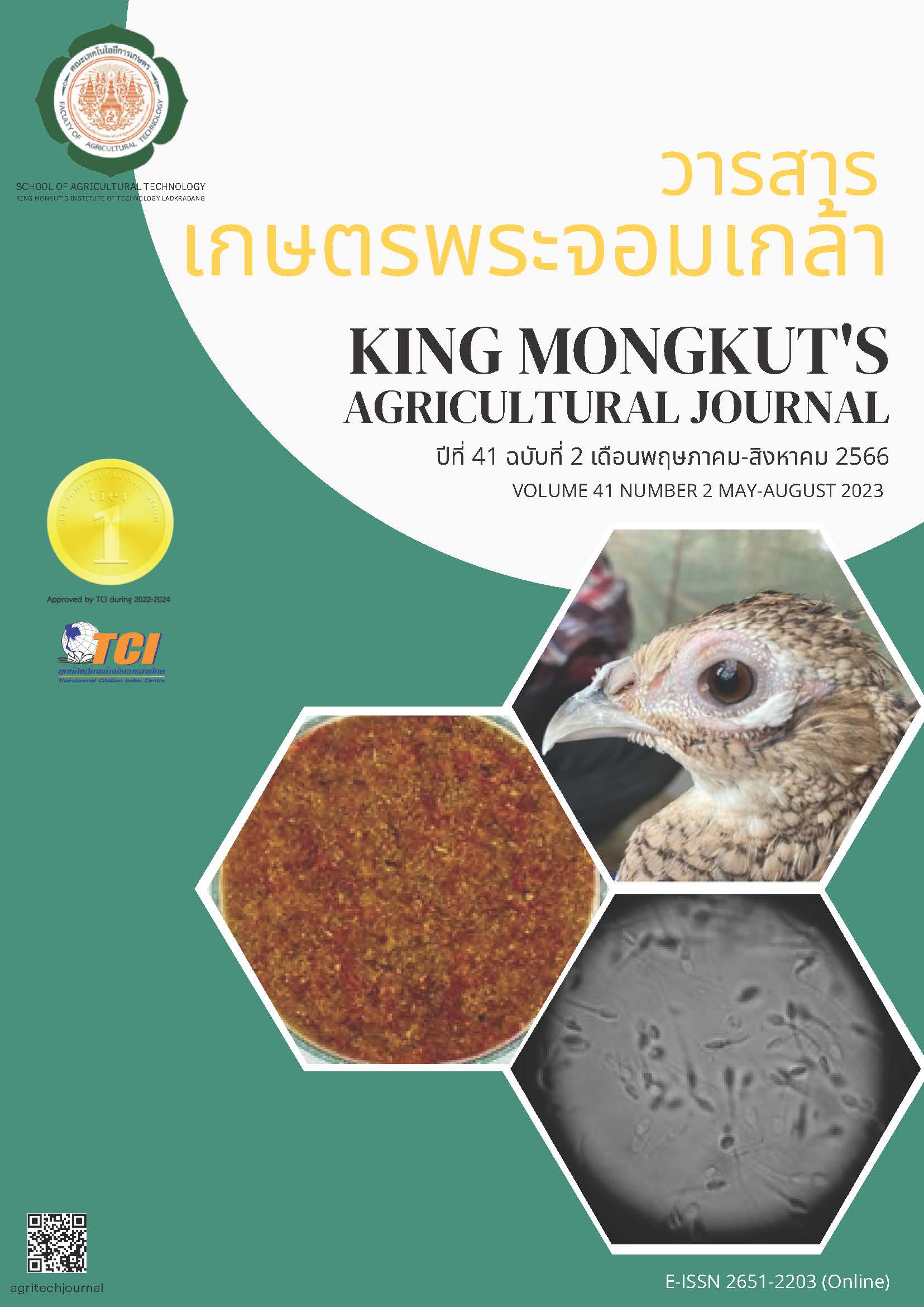ผลการใช้เมล็ดทุเรียนบดเป็นแหล่งพลังงานในอาหารข้นต่อปริมาณการกินได้ และเมแทบอไลต์ในเลือดแพะ
Main Article Content
บทคัดย่อ
การวิจัยครั้งนี้มีวัตถุประสงค์เพื่อศึกษาผลของการใช้เมล็ดทุเรียนบดเพื่อใช้เป็นแหล่งพลังงานในสูตรอาหารข้น ร่วมกับการใช้ทางใบปาล์มหมักเป็นแหล่งอาหารหยาบต่อปริมาณการกินได้และเมแทบอไลต์ในเลือดแพะ โดยใช้แพะพื้นเมือง เพศผู้ อายุ 1.5 ปี น้ำหนักตัวเฉลี่ย 24.20±1.15 กิโลกรัม จำนวน 5 ตัว ใช้แผนการทดลองแบบ 5 x 5 ลาตินสแควร์ แบ่งแพะทดลองออกเป็น 5 กลุ่ม ให้แพะได้รับทางใบปาล์มน้ำมันหมักเป็นแหล่งอาหารหยาบแบบเต็มที่ อาหารข้นใช้เมล็ดทุเรียนบดทดแทนข้าวโพดบดในระดับ 0, 25, 50, 75 และ 100 เปอร์เซ็นต์ ผลการทดลองพบว่า เมล็ดทุเรียนบดมีคุณค่าทางโภชนะ ได้แก่ วัตถุแห้ง อินทรียวัตถุ โปรตีน ไขมัน คาร์โบไฮเดรตที่ละลายได้ง่าย เยื่อใยที่ไม่ละลายในสารละลายที่มีฤทธิ์เป็นกลาง ลิกโนเซลลูโลส และลิกนิน เท่ากับ 32.93, 95.90, 8.48, 0.26, 81.50, 43.76, 24.09 และ 14.32 เปอร์เซ็นต์ ปริมาณวัตถุแห้งที่กินได้ (1,162.28-1,287.03 กรัมต่อตัวต่อวัน) และโปรตีนที่กินได้ (140.32-153.92 กรัมต่อตัวต่อวัน) ไม่แตกต่างกันทางสถิติ (P>0.05) อย่างไรก็ตาม ปริมาณการกินได้ของอินทรียวัตถุในแพะที่ได้รับเมล็ดทุเรียนบดทดแทนข้าวโพดบดในระดับ 50 และ 100 เปอร์เซ็นต์ มีค่าสูงกว่าแพะที่ได้รับเมล็ดทุเรียนบดทดแทนข้าวโพดบดในระดับ 25 เปอร์เซ็นต์ (837.30 กรัมต่อตัวต่อวัน) นอกจากนั้น ค่าปริมาณเม็ดเลือดแดงอัดแน่น กลูโคส และยูเรียไนโตรเจนในเลือดของแพะทุกกลุ่มมีค่าไม่แตกต่างกันทางสถิติ (P>0.05) ดังนั้น จึงสรุปได้ว่าสามารถใช้เมล็ดทุเรียนบดเป็นแหล่งพลังงานในอาหารข้นสำหรับแพะได้ โดยไม่ส่งผลกระทบต่อปริมาณการกินได้ และเมแทบอไลต์ในเลือดแพะ
Article Details

อนุญาตภายใต้เงื่อนไข Creative Commons Attribution-NonCommercial-NoDerivatives 4.0 International License.
วารสารเกษตรพระจอมเกล้า
เอกสารอ้างอิง
Bhatt, H. D., Kelawala, N. H., Dabas, V. S., Bhatt, R. H., Jhala, S. K., Suthar, D. N. & Dodia, V. D. (2016). Incidence of hoof disorders in bovine of south Gujarat. International Journal of Science Environment and Technology. 5(5), 3346-3351.
Bolsen, K. K., Curtis, J. L., Lin, C. J. & Dickerson, J. L. (1990). Silage inoculant and indigenous micro flora with emphasis on alfafa.
In The 6th Biotechnology in the in feed industry proceeding of Alteoh’s sixth annual symposium. (pp. 431-443). Kentucky: Altech Technology Publication.
Brown, M. J., Hor, Y. L. & Greenwood, J. S. (2001). Reserve accumulation and protein storage vacuole formation during
development of recalcitrant seeds of Durio zibethinus L. Seed Science Research Journal. 11(4), 293-303.
Cheva-Isarakul, B. (2003). Raising and managing goats. Chaing Mai: Faculty of Agriculture Chiang Mai University. (in Thai).
Department of Livestock Development [DLD]. (2004). Nutritive values of feed stuff. Bangkok: Printing House of the Agricultural
Cooperative Association of Thailand Limited. (in Thai).
Department of Livestock Development [DLD]. (2008). Nutrient Requirements of Beef Cattle in Thailand. Retrieved from:
https://pvlo-cmi.dld.go.th. (in Thai).
Idris, A. B. & Mohd, N. (2003). Role of silage from fodder, crop residues and agro-industrial by-products in commercial livestock
production. In The 2nd Forage and feed resources in commercial livestock production system. (pp. 99-103).
Kuala Lumpur: Malaysia.
Ishida, M. & Abu Hassan, O. (1997). Utilization of oil palm frond as cattle feed. Japan Agricultural Research Quarterly. 31(1), 41-47.
Jain, N. C. (1993). Esssential of Veterinary Heamatology. Philadelphia: Lea & Febiger.
Kaneko, J. J. (1989). Clinical Biochemistry of Domestic Animal. 4th ed. California: Academic Oress Inc.
Khamseekhiew, B., Liang, J. B., Jelan, Z. A. & Wong, C. C. (2002). Fibre degradability of oil palm frond pellet, supplemented with
Arachis pinto in cattle. Songklanakarin Journal of Science and Technology. 24(2), 209-216. (in Thai).
Lloyd, S. (1982). Blood characteristics and the nutrition of ruminants. British Veterinary Journal. 138(1), 70-85.
Lunsin, R., Duanayi, S., Pilajun, R., Cherdthong, A. & Wanapat, M. (2017). Effect of level of oil palm front pellet replacement
concentrate on milk yield and economical of return in lactating dairy cow. Khon kaen Agricultural Journal. 45(1), 654- 659. (in Thai).
Miller, L. A., Moorby, J. M., Davies, D. R., Humphreys, M. O., Scollan, N. D., MacRae, J. C. & Theodorou, M. K. (2001). Increased
concentration of water-soluble carbohydrate in perennial ryegrass (Lolium perenne L.): milk production from late-
lactation dairy cows. Grass and Forage Science. 56(4), 383-394.
Müller C. E., Nostell K. & Bröjer, J. (2016). Methods for reduction of water soluble carbohydrate content in grass forages for
horses. LivestockScience. 186(Suppl.1), 46-52.
Ninlanon, W., Puttame, K. & Sawasdikan, J. (2019). Effects of Durian Seed Preparation on Durian Seed Flour Properties. Rajabhat
Rambhai Barni Research Journal. 13(3), 114-119. (in Thai).
Nutrient requirements [NRC]. (1981). Nutrient Requirements of goat: Angora, dairy and meat goats in temperate and Tropical
countries. Nutrient requirements of Domestic Animals. 15th ed. Washington, DC: National Acedemes of Science.
Nutrient requirements [NRC]. (2000). National research council Nutrient requirement of beef cattle. 70th ed. Washington, DC:
Academy Press.
Office of Agricultural Economics [OAE]. (2020). Agricultural product production information. Retrieved from: http://mis-app.oae.go.th. (in Thai).
Purnomo, A., Yudiantoro, Y. A. W., Putro, J. N., Nugraha, A. T., Irawaty, W. & Ismadji, S. (2016). Subcritical water hydrolysis of durian seeds waste for bioethanol production, International Journal of Industrial Chemistry. 7(3), 29-37.
Statistical Analysis System [SAS]. (1996). SAS User’s Guide. Version 6.12. North Carolina: SAS Institute Inc.
Steel, R. G. D. & Torrie, J. H. (1980). Principles and Procedures of Statistics: A Biometerial Approach. 2nd ed.
New York: McGraw-Hill.
Tadsri, S. (2004). Tropical forage grasses. Bangkok: Kasetsart University Press. (in Thai).
Vitidsant, T. (2010). Position paper on biofuel development in Thailand. Bangkok: Center of Flues and Energy from Biomass. (in Thai).
Wan Zahari, M. & Alimon, A. R. (2004). Use of palm kernel cake and oil palm by-products in compound feed. In Oil Palm
Developments. (pp. 5-9). Selangor: Universiti Putra Malaysia.
Wan Zahari, M., Alimon, A. R. & Wong, H. K. (2012). Utilization of oil palm co-products as feed for livestock in Malaysia. Kelantan: Universiti Malaysia Kelantan.
Waramit, W., Phuangborisut, S., Wetchagool, W., Wetchagool, N. & Phattapanit, V., (2016). Effect of Dietary Substitution of Durian
Seed Starch for Broken Rice on Productive Performance in Broiler. Prawarun Agricultural Journal. 13(2), 145-152. (in Thai).


